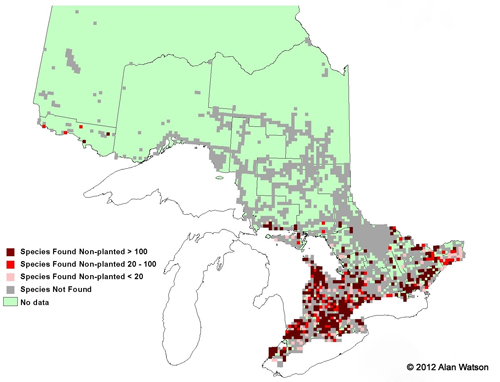silver maple
silver maple - Acer saccharinum
This fast-growing maple species is common throughout southern and central Ontario. The silver maple requires a lot of space, but loves to grow in wetter areas, such as woods near wetlands or streams. The notoriously weak wood of the silver maple means lots of fallen branches, but the often hollow trunks provide excellent dens and nesting cavities for many animals, such as owls, wood ducks, and raccoons! The leaves are easy to identify by the deep, narrow notches separating 5-7 lobes (usually only 5 on sugar maple leaves), and the pale white undersides.

Note the deep notches of silver maple leaves

Silver maple leaves are quite whitish underneath. Photo by Brian Lacey.

Silver maple keys are very large and distinctively shaped. The buds and leaves also provide food for a long list of wildlife species.

Ontario Tree Atlas map of non-planted Silver Maples. 1995-1999.
References
Farrar, J.L.. 1995. Trees in Canada. Fitzhenry & Whiteside Ltd. Toronto. ON. 504 pp.
Kershaw, L. 2001. Trees in Ontario: Including tall shrubs. Lone Pine Publishing. Edmonton. AB. 240 pp
Muma, W. 2011. Ontario Trees and Shrubs. [Online] Available: www.ontariotrees.com
OMNR, 2011. Ontario Ministry of Natural Resources: Ontario Tree Atlas. [Online] Available: http://www.mnr.gov.on.ca/en/Business/ClimateChange/2ColumnSubPage/267027.html
OMNR, 2008. Ontario’s Biodiversity: Species at Risk.